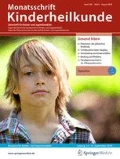Zusammenfassung
Hintergrund
Schmerzen bei stationär aufgenommenen Kindern werden häufig unzureichend behandelt. Bisher gab es keine Informationen zum Schmerzmanagement von Kinderkrankenhäusern in der Schweiz. Ziel der vorliegenden Studie war, den aktuellen Stand der Schmerzerfassung, -interpretation und -behandlung zu bestimmen.
Studiendesign
Ein Fragebogen wurde an alle pädiatrischen Krankenhäuser in der Schweiz gesendet.
Ergebnisse
Insgesamt antworteten 27 von 45 Einheiten (Antwortrate: 60%). Die meisten Abteilungen verwenden Schmerzerfassungstools (96%) und führten diesbezügliche Leitlinien ein (78%). Die Behandlung von Schmerzen erfolgt ebenfalls meist nach hausinterner Leitlinie (78%). Prozedurale und postoperative Schmerzen werden stets (100%) analgetisch behandelt. Bei Frühgeborenen und Kindern auf Intensivpflegestationen werden bei invasiven Eingriffen häufig Analgetika (> 87%) verwendet. Auf Intensivstationen liegen in 44% diesbezügliche Leitlinien vor.
Resümee
Der Nutzen eines effektiven Schmerzmanagements bei Kindern ist eindeutig belegt. Viele Ansätze zur Verbesserung werden in der Schweiz gut umgesetzt. Vor allem im internationalen Vergleich verbesserte sich das Schmerzmanagement. Es gibt aber noch Optimierungsmöglichkeiten. Beispielsweise besitzen weniger als die Hälfte aller schweizerischen Intensivstationen eine Leitlinie für die Behandlung von Schmerzen bei invasiven Eingriffen.
Abstract
Objective
Pain in hospitalized children is often undertreated. The aim of the study was to assess the current pain management for children in Switzerland.
Study design
A postal questionnaire was sent to all pediatric units in Switzerland.
Result
A total of 27 of 45 units replied (60% response). Most units used tools for pain assessment (96%) and had a guideline for pain management (78%). Procedural and postoperative pain are always (100%) treated. Premature infants and children in intensive care units often (> 87%) receive analgesics during invasive procedures. However, only 44% of intensive care units have a guideline for this.
Conclusion
Benefits of an effective pain management in children are well established. Many measures have been applied in Switzerland. However, there is still room for improvement, e.g., less than half of all intensive care units rely on guidelines for analgesics during invasive procedures.
Literatur
American Academy of Pediatrics, Committee on Psychosocial Aspects of Child and Family Health; Task Force on Pain in Infants, Children, and Adolescents (2001) The assessment and management of acute pain in infants, children, and adolescents. Pediatrics 108:793–797
Anand K (2000) Pain, plasticity, and premature birth: a prescription for permanent suffering? Nat Med 6:971–972
Andrews K, Fitzgerald M (1999) Cutaneous flexion reflex in human neonates: a quantitative study of threshold and stimulus-response characteristics after single and repeated stimuli. Dev Med Child Neurol 41:696–703
Bellieni C, Buonocore G (2008) Neonatal pain treatment: ethical to be effective. J Perinatol 28:87–88
Berde C, Sethna N (2002) Analgesics for the treatment of pain in children. N Engl J Med 347:1094
Buttner W, Finke W (2000) Analysis of behavioural and physiological parameters for the assessment of postoperative analgesic demand in newborns, infants and young children: a comprehensive report on seven consecutive studies. Paediatr Anaesth 10:303–318
Duhn LJ, Medves JM (2004) A systematic integrative review of infant pain assessment tools. Adv Neonatal Care 4:126–140
Grunau RE, Whitfield MF, Petrie-Thomas J et al (2009) Neonatal pain, parenting stress and interaction, in relation to cognitive and motor development at 8 and 18 months in preterm infants. Pain 143:138–146
Hammer GB (2008) Sedation and analgesia in the pediatric intensive care unit following laryngotracheal reconstruction. Otolaryngol Clin North Am 41:1023–1044, x–xi
Hammer GB (2009) Sedation and analgesia in the pediatric intensive care unit following laryngotracheal reconstruction. Paediatr Anaesth [Suppl 1] 19:166–179
Harrison D, Loughnan P, Johnston L (2006) Pain assessment and procedural pain management practices in neonatal units in Australia. J Paediatr Child Health 42:6–9
Lehr VT, Taddio A (2007) Topical anesthesia in neonates: clinical practices and practical considerations. Semin Perinatol 31:323–329
Maher EN, Hansen SF, Heine M et al (2007) Knowledge of procedural sedation and analgesia of emergency medicine physicians. Pediatr Emerg Care 23:869–876
McKechnie L, Levene M (2008) Procedural pain guidelines for the newborn in the United Kingdom. J Perinatol 28:107–111
Polaner DM (2001) Sedation-analgesia in the pediatric intensive care unit. Pediatr Clin North Am 48:695–714
Slater R, Cornelissen L, Fabrizi L et al (2010) Oral sucrose as an analgesic drug for procedural pain in newborn infants: a randomised controlled trial. Lancet 376:1225–1232
Slater SM, Micallef MC, Zhang J et al (2010) Identification and characterization of a null-activity mutant containing a cryptic pre-mRNA splice site for cytosolic fructose-1,6-bisphosphatase in Flaveria linearis. Plant Mol Biol 74:519–536
Statler KD, Lugo RA (2004) Surveying sedation and analgesia practice in the pediatric intensive care unit: discomforting data raise further questions. Pediatr Crit Care Med 5:582–583
Stevens B, Taddio A, Ohlsson A et al (2008) The efficacy of sucrose for relieving procedural pain in neonates – a systematic review and meta-analysis. Acta Paediatr 86:837–842
Swafford Li AD (1968) Pain relief in the pediatric patient. Med Clin North Am 52:131–136
Taddio A, Katz J, Ilersich A et al (1997) Effect of neonatal circumcision on pain response during subsequent routine vaccination. Lancet 349:599–603
Tobias JD (2000) Tolerance, withdrawal, and physical dependency after long-term sedation and analgesia of children in the pediatric intensive care unit. Crit Care Med 28:2122–2132
Tobias JD (2005) Sedation and analgesia in the pediatric intensive care unit. Pediatr Ann 34:636–645
Zempsky WT, Cravero JP (2004) Relief of pain and anxiety in pediatric patients in emergency medical systems. Pediatrics 114:1348–1356
Zempsky WT, Schechter NL (2003) What’s new in the management of pain in children. Pediatr Rev 24:337–348
Zier JL, Liu M (2011) Safety of high-concentration nitrous oxide by nasal mask for pediatric procedural sedation: experience with 7802 cases. Pediatr Emerg Care 27:1107–1112
Interessenkonflikt
Der korrespondierende Autor gibt für sich und seine Koautoren an, dass kein Interessenkonflikt besteht.
Author information
Authors and Affiliations
Corresponding author
Rights and permissions
About this article
Cite this article
Boettcher, M., Göttler, S., Stoffel, L. et al. Schmerzmanagement bei Kindern in der Schweiz. Monatsschr Kinderheilkd 160, 887–894 (2012). https://doi.org/10.1007/s00112-012-2680-y
Published:
Issue Date:
DOI: https://doi.org/10.1007/s00112-012-2680-y

